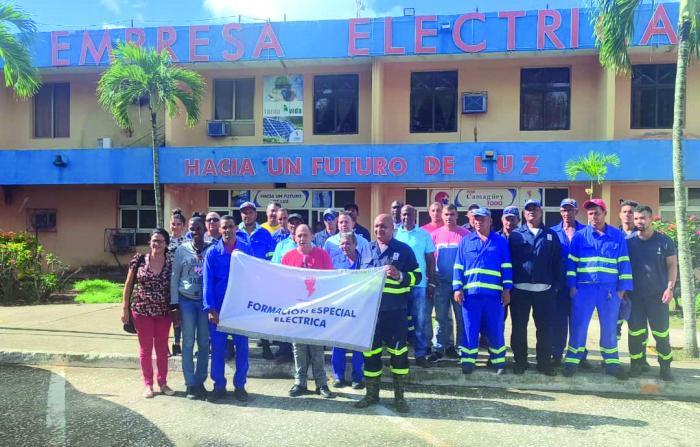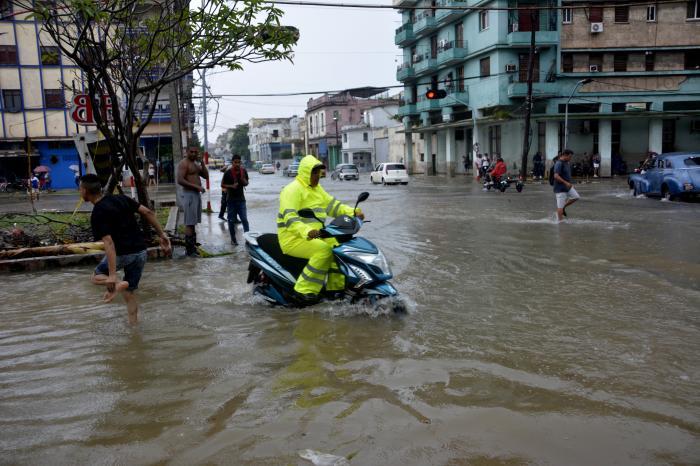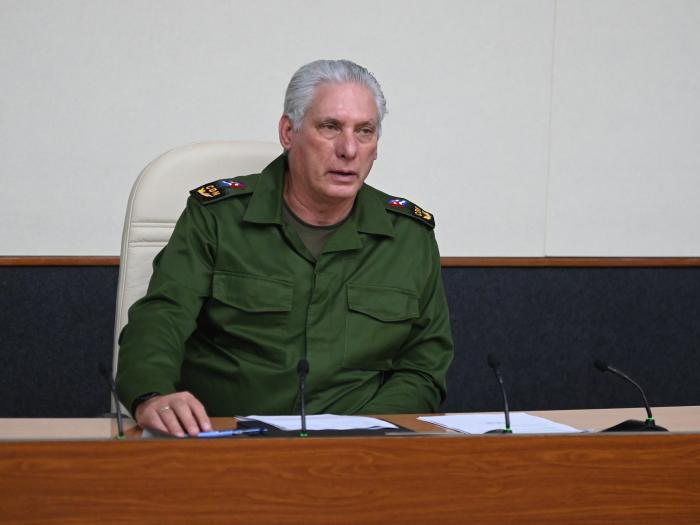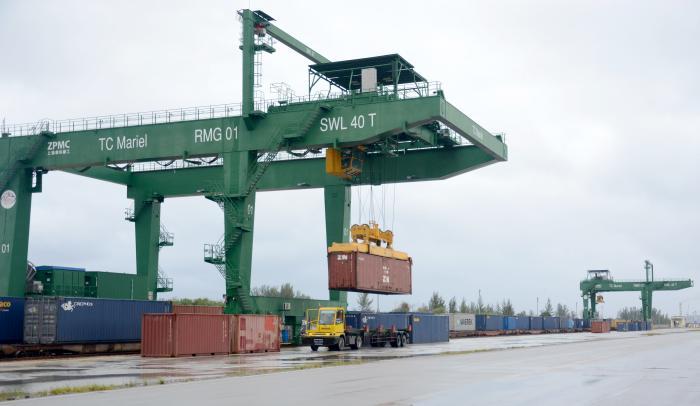

The brigades already on Guantánamo soil, coming from Santiago de Cuba, Holguín and other provinces, have been joined by a Special Electric Formation from Camagüey. Photo: Jorge Enrique Jerez Belisario
When the heavy damages caused by hurricane Oscar in Guantanamo became known, a wave of solidarity began to arise to help those who have lost almost everything. Clothes, shoes, toiletries, food... Anything goes at this time when Cuba is at the disposal of San Antonio del Sur, Imías, Baracoa and Maisí. The people of the largest of the Antilles have not lost the sensitivity learned in more than 60 years of the Revolution, which has taught them, based on category five lessons, that the suffering, the victim, the victimized... can never be abandoned.That is why, even before any authority evaluated the damage and indicated actions for emergency rescue and salvage, the neighbor was already carrying in his arms his children and those next door, or helping in the middle of the night the elderly who were surprised by the sudden rise of the waters in the Cuban semi-desert, an area of Cuba where it rarely rains... and much less floods. And there is also the one who shared his meager food in days of blackouts and galloping inflation, and who gave encouragement, for lack of anything else, in the face of the loss of everything accumulated in a life of effort by so many humble inhabitants of the Cuban Upper East.ALL POSSIBLE SOLIDARITYAt dawn this Wednesday, in the emblematic Plaza de la Patria of Bayamo, the second contingent of this eastern territory was flagged off to the sister province of Guantanamo, to contribute to the recovery work in the most affected areas there, after the passage of the hurricane, which became a tropical storm.Preceded by a brigade of electricians from Granma province, the Armando Mestre Martinez construction contingent left with the purpose of supporting the rehabilitation works in the roads of the Guantanamo municipality of San Antonio del Sur.The experienced group is made up of workers, technicians and executors, together with 15 teams from the province, including loader and dump trucks, bulldozers, motor graders and backhoes. Also, as part of the gestures of solidarity that are multiplying in the Granma territory, several state institutions, economic actors and groups of people in social networks have called for the collection of donations destined to the people who suffered the onslaught of the meteorological event.Meanwhile, students from the 13 de Marzo guerrilla group, from the University of Medical Sciences of Granma; artists from the provincial catalog of Culture; and agricultural workers in the territory have expressed their willingness to leave for Guantánamo to help in whatever task is needed.To the brigades already on Guantanamo soil, coming from Santiago de Cuba, Holguin and other provinces, a Special Electric Formation from Camagüey, with the name of Ignacio Agramonte, has been added.Three brigades and a total of 42 workers, mainly linemen, with specialized means and equipment, are heading initially to Baracoa, one of the territories most affected by the force of the winds, and then they will continue helping in other areas in the eastern province.For Andrés Ricardo Burgos, this is his eleventh occasion supporting recovery from meteorological phenomena. With 38 years of experience and 21 years as 110 kv brigade chief, since Oscar touched Cuban soil he knew he would leave to help other provinces."It is always my turn and we always step forward, my boys and I, because we know that we are needed and that many people need us at this time. Now begins the task of taking care of ourselves, so that we can all return," he told Granma newspaper.ROADS ENABLED TO SUPPORT THE VICTIMSIn response to the devastating effects of the meteorological event, the Central Bank of Cuba (BCC) set up accounts to make donations to the affected families, so that the people can contribute to the recovery of the most affected areas.Through electronic payment channels or by depositing cash at any bank branch, transfers can be made to the following accounts: 0699983004299919 (Bandec); 1299731002599715 (BPA) and 0598770006615919 (Banco Metropolitano S.A.).Another show of solidarity towards the Cuban Upper East are those carried out by the mass organizations. The Federation of Cuban Women (FMC), the Union of Young Communists (UJC), the Committees for the Defense of the Revolution (CDR) and the Cuban Workers' Central (CTC) have called for donations of clothes, toiletries, unprocessed food... and any other contribution, destined to those who lost everything. Beyond the organizations, there have also been articulated citizen and church initiatives, through which it has already been possible to reach some food and supplies to some localities to which the access from the city of Guantanamo has been interrupted.ASSISTANCE IS BEING ORGANIZEDThe Guantánamo Provincial Transportation Delegation supports the Defense Council's transportations, including with triple traction equipment, to deal with power outages and to reach areas of difficult access. Work is being carried out in the extraction of the standardized family basket from the port of Santiago de Cuba. Two days ago 389 tons were extracted, and on Monday more than 20 means of transport were used to take another 300 tons of rice to Guantanamo. Between Friday and Monday, the Santiago de Cuba-Guantanamo university train will operate normally, but without intermodal access, because the passage to the eastern municipalities is very uncertain.On Saturday, the Guantánamo-Holguín train should operate normally.La Farola is very affected. Work is being done to solve them. Transportation of medical brigades for Imías and San Antonio del Sur is guaranteed.Source: Ministry of Transportation
HURRICANES IN RECENT YEARS (chronology)201815 tropical storms, of which eight became hurricanes (two of which were major hurricanes).For the first time there were seven storms that were subtropical at some point in their lifetimes.No hurricanes formed in the Atlantic during August, which had not occurred since 2013.Cuba was affected by subtropical storm Alberto, which caused heavy rains from Pinar del Rio to Ciego de Avila, between May 26 and 31. It was also impacted by Hurricane Michael (category 1), whose heavy rains hit Pinar del Río and Artemisa hard on October 8 and 9.201918 tropical storms, of which six became hurricanes (three of them of great intensity).Although it was one of the most active seasons in historical records, no cyclonic organism of importance affected Cuba or the Caribbean Sea.202030 tropical storms, of which 14 became hurricanes (seven of them of great intensity).The number of tropical storms and hurricanes was above the averages for the period 1965-2008, which are 10.6 and 6.1, respectively.Cuba was directly affected by Laura and Eta, both with tropical storm force, causing considerable damage to electrical service, housing, agriculture and the economy in general.202121 tropical storms, of which seven became hurricanes (four of them of great intensity).Hurricane Elsa, category 1, in July, and Ida, category 4, in August, affected western Cuba. Meanwhile, tropical storm Fred made itself felt with its heavy rains in almost the entire country.202214 tropical storms, of which eight became hurricanes (two of them of great intensity).Cuba was hit in September by the powerful category 4 hurricane Ian in September, which killed three people and left serious damage to more than 100,000 homes, power and electricity.100,000 homes, electricity and agriculture, especially in the west of the country. The National Electric System was disconnected.202320 tropical storms, of which seven became hurricanes (three of them of great intensity).The Island was impacted by tropical storms Arlene in June and Harold in August, as well as by Hurricane Idalia in August. The latter resulted in flooding, power outages, downed trees and landslides.Sources: Institute of Meteorology and Meteorological Center of Sancti Spíritus.





